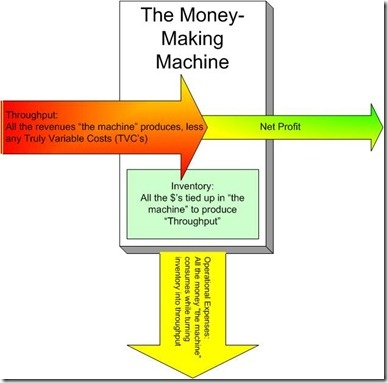What’s wrong with “brainstorming”?
Well, nothing, in one sense.
The wonderfully egalitarian concept that “no idea is a bad idea” suggests that every idea is equally valuable.
Of course, when the rubber meets the road—as the discussion inevitably evolves during the “brainstorming session”—it becomes quite obvious that every idea was not equal, and that some ideas definitely had more bearing on the question, problem or issue at hand than did other ideas.
Nevertheless, in a business environment, probably the biggest problem with brainstorming isn’t even with its sort of haphazard approach to the discovery of business solutions. The biggest problem with brainstorming lies in the context in which it is far too frequently applied.
For-profit organizations are intended to be money-making machines.
The function of a for-profit organization's money-making process may be defined by three critical factors:
- Throughput – all of the money the machine takes in, less all of the Truly Variable Costs (TVC) it took to produce the goods or services leading to the revenues
- Investment – all of the money the business (the system) has tied up in the process of producing Throughput
- Operating Expenses – all of the money the business pays out (day after day, month after month) to support the production of Throughput
As Peter Drucker so wisely pointed out: All of the profit lies outside the organization and outside its direct control. Inside the organization, all you have is costs.
Clearly, if the for-profit organization’s goal is to make more money tomorrow than it is making today—which is what it should be—then two things must happen with certainty:
- Every other goal must be recognized as subsidiary to that singular overarching goal. You may want to offer the best customer service, or the highest quality products, or set another lofty-sounding goal, but your continuing to offer the best customer service, the highest quality products or attaining any other objective is dependent upon your firm’s ability to make profits. That’s not greed at work. That’s simply a fact of life. (Note: In not-for-profit firms, the goals may be otherwise, but we are dealing with for-profit organizations presently.)
- Organizational leadership must recognize that it is the system’s (the business’s) ability to increase Throughput that is key to ongoing improvement. One-time or short-term improvements may be achieved through cost-cutting, but the key to any process of ongoing improvement (POOGI) is in increasing the “flow” of goods and services that result in Throughput.
So, let’s turn back to brainstorming: I said that the biggest problem with the application of brainstorming is, generally, the context in which it is applied.
Executives and managers hold brainstorming sessions over “problems” they are struggling with in sales or marketing or customer service or human resources or purchasing or production or their supply chain. They do this without realizing that optimizing subsystems does not lead to the optimization of the whole system.
I recall back in the 1980s, when U.S. automobile manufacturers were struggling and failing to meet the challenges being posed to them by the onslaught of Japanese auto-makers like Toyota and Honda. A story appeared in a prominent business magazine about how one of the Big Three U.S. automakers had undertaken modernization of its accounts payable department and how the investment would save the firm several millions of dollars every year.
Of course, while they were doing this, the whole firm—their “system”—was still losing many billions of dollars every year. Optimizing—if, in fact, they actually did “optimize”—accounts payable should not have been their first priority unless that department happened to be the company’s bottleneck to increasing Throughput and profits. Clearly, it was not the bottleneck, as the following year’s losses where not significantly better than the preceding year’s billions.
Brainstorming, as a standalone tool, offers no way to help management see their whole “system” and how its inter-related departments and functions work. It is very difficult for a single department (a limb of one tree) to comprehend what is really happening system-wide (in the whole forest).
As Lisa J. Scheinkopf says in Thinking for a Change, “When we want to understand what is constraining an organization from achieving its purpose [or, goal], we should enlarge our perspective… from the Function Box to the Value Chain Box.” We need to have a view, “our perspective of the organization” as though we were hovering “over [the enterprise] at an altitude of 40,000 feet” and witnessing the “flow,” not just individual functions.
This is the beginning of “system thinking,” and we may yet find a place for “brainstorming.”
Stay tuned for Part 2—coming soon.




